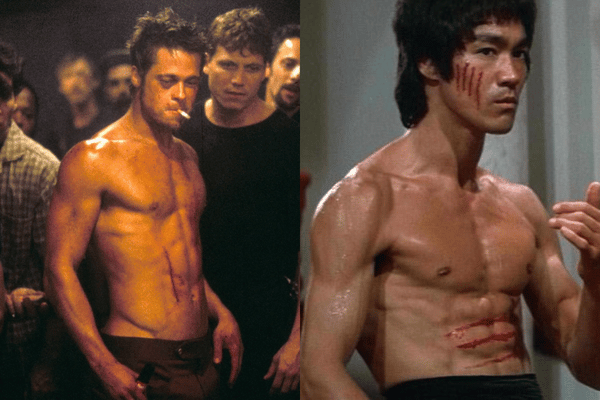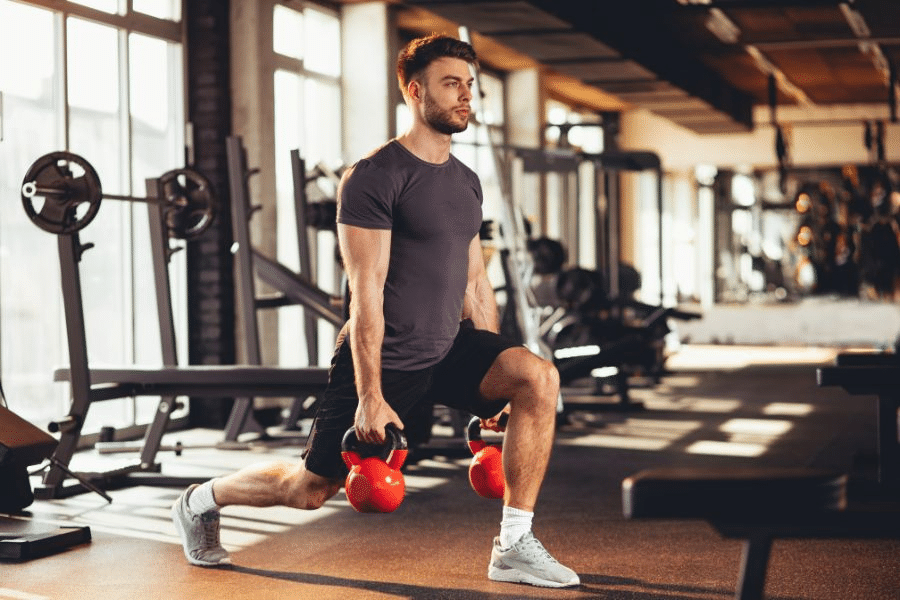What is the ideal male physique? Most would include broad muscular shoulders, good upright posture, narrow waist, and visible muscle tone, aka the “V shape.” This body shape epitomizes physical power, health, and masculinity. But not everyone is naturally blessed with this structure. If you don’t have a natural v shape upper body or want to improve your current shape, don’t worry, it is possible to obtain this physique and its many benefits. We’ll go over a V shape body workout that can help you look more like the gentlemen below.

Finding the ratio
What is the ideal ratio for this V shape? According to the Grecian ideal, a 1.6 shoulder to waist ratio will give you the perfect upper body proportions. So if you have a 32 inch waist, you want to aim for 51 inch shoulders.
From the eye test, the pictures of Brad Pitt in Fight Club or Bruce Lee in Enter the Dragon above represent this figure (and much more around masculinity… but that is for another day).
But why should a gentleman worry about such physical measurements? The benefits are many. For one, clothes will look better on you. Tailored clothing such as well-fitting suits and sport coats will accentuate this shape and give you a more masculine appearance.
This ratio is the hallmark of male physical fitness, and a gentleman should take care of his natural fitness and appearance. A V shaped upper body looks heroic and capable, two things that every man should strive to achieve.
A good physique AND stylish, well-fitting clothes will give others the first impression of power, discipline, competence, and confidence – traits that any gentleman should exude. These will benefit you in your professional, personal, and romantic life. Women are hardwired to gravitate towards this body shape, as many studies have proven.
Assessing your goals
You’ll notice that Brad Pitt or Bruce Lee are not hulked out like many actors in other movies. With the right plan, most men can achieve a similar physique. But it takes time, discipline, and the right program.
First, you must measure your waist and your shoulder circumference. You can then attack the area that needs the most immediate work.
To start, multiply your height by 0.46. This will determine your ideal waist measurement. For someone who is 6 ft tall, this comes out to a 33 inch waist. Then you can multiply this by 1.6 (for the 6 ft guy, this puts you at about 53 inches) for your ideal shoulder measurement.
Now you have a starting point. If you are closer to the ideal shoulder size, you can focus on losing fat. If you are closer to the ideal waist size, you can focus on gaining muscle.
Note: some people will have naturally larger or smaller frames. You can still achieve this 1.6 ratio, but you will likely have to adjust your starting numbers a bit. For instance, if you have a narrow frame, a 30 inch waist and 48 inch shoulders will be a better goal for you. The ratio matters the most.
Workout plan – narrowing the waist
If you have naturally wide shoulders but you’re carrying some extra width around your waist, your plan will be straightforward – lose weight.
It’s not easy to lose weight (or we wouldn’t have to mention it), but setting a concrete aesthetic goal of a 1.6 shoulder to waist ratio can give you the motivation to get started. Remember the benefits? Keep those in mind.
As far as programming, I personally recommend this program. It costs money (I don’t get a commission, I just like the methodology) but is very complete. If you want to start with some free resources, here is a great article.
Our advice? Follow the basic principles below. The best workout for weight loss starts in the kitchen.
General weight loss framework
- Losing weight is primarily about your diet. It will determine 80% or more of your success.
- Stick to whole foods (meat, fish, yogurt, fruit, veggies, fibrous carbs) that are prepared with little added calories (nothing fried)
- Avoid the following – processed foods (anything in a box or bag), high carb foods (any food with added sugar, most grains like bread and pasta, potatoes, rice, etc…), and alcohol (in moderation if you must, but any amount will go against your goal to lose weight). Some high carb foods are good for you, but they make it hard to lose weight if that is your goal. Save those for when you hit your target waist measurement
- Eat enough protein (shoot for 1g per pound of your target weight). Here is our meal planning advice. Count calories if you have to.
- Regular cardio will help speed up the process. Walk at least 30 minutes a day. If you are able, perform 2 high intensity interval training (HIIT) workouts per week – find something you like (cycling, sprinting, rowing, speed walking, playing a sport) and stick to this. Longer jogging can work for some, but if you are heavy it can be hard on your joints.
- Lift weights according to the program in the next section. This will help you maintain muscle mass. Don’t expect to gain muscle while losing weight unless you have never worked out before.
Workout plan – broadening the shoulders
If you are below 15% body fat or so, or you are closer to the ideal waist measurement than the ideal shoulder width, you should focus on building bigger shoulder and back muscles.
Building bigger shoulders is obvious, but you also need to strengthen the upper back to improve your posture – this will pull your shoulders back and naturally add width to your upper body. Additionally, increasing the size of your lats will add to the V shape.
Another consideration is to make sure you’re working all three muscles in the shoulder: lateral, posterior, and anterior deltoids. These are the scientific names for front, middle, and rear shoulder muscles. You want to make sure that you’re hitting all three in order to have good symmetry with your shoulders. Our friends at A Lean Life have some solid shoulder workouts that focus on this important symmetry.
For some, shoulders are easy to build. You can do some shoulder presses and rows, and your shoulders will pop. For most people, and you are probably in this group if you are reading this article, building these muscles is difficult and requires special programming with more isolation exercises.
Below is a sample V shape body workout. You can adjust based on how well it works for you over time. If you want something more in-depth, I recommend you purchase this program (it worked great for me).
- Warm-up (I’ll do some shoulder mobility work, side and front raises with very light weight, and a set of bodyweight facepulls)
- 3 sets x 8-10 reps seated rows (I prefer chest supported machine rows, but DB or cable rows work too)
- 3×10-12 seated DB shoulder press
- 3xAMRAP (as many reps as possible) pull-ups OR 3×10-12 pull-downs
- 2×15-20 DB or cable side raise
- 2×15-20 overhead plate raise
- 2×15-20 rear delt fly
- 2×15-20 facepulls
General workout advice
You can perform the V shape workout 1-2 times per week, in addition to your other body parts (back, legs, chest). This workout is actually a pretty balanced upper body workout, if you want to do it 2-3 times per week with no other upper body days (may want to throw in a horizontal press like an incline DB bench or machine chest press at 3 sets by 8-12 reps).
You should reach positive failure on the last set or two, meaning you can’t do another rep with good technique if someone had a gun to your head. This analogy usually helps me pump out 1-2 more reps.
If you don’t know how to do any of the above exercises, google them and watch the video. Make sure to use proper technique rather than trying to lift as much as possible. The weights are a tool to improve your strength and aesthetics, so don’t worry about the amount you’re lifting. It’s more important that you work the muscle through the range of motion with controlled movement, rather than trying to hoist up as much weight as you can. The goal is to stimulate your muscles, not feed your ego.
Progressive overload
Apply progressive overload to your workouts, meaning each session your weight or reps should increase incrementally. Even if the increase is small between each workout (one additional rep over three sets), you will eventually create the additional stimulus needed to grow your muscles.
As far as increasing weight, start with a weight where you reach positive failure around the low end of the rep range for each exercise (so you can only do 10 reps at a given weight, for instance), then keep increasing reps (even by one) with each workout until you get to the high end of the rep range (15 or 20, depending on the exercise). Then increase the weights by 5-10 lbs for that exercise and start the process again.
Diet for gaining muscle
The same diet principles apply to the diet for weight loss, except you’ll want to eat more. You can add more carbs to this framework, but try to keep them “clean.” Rice, potatoes, sweet potatoes, oats, some bread (if you tolerate it) and pasta. If your waist measurement starts to creep up, then cut back on the carbs.
Make sure to optimize your testosterone. This will help you build muscle faster. The V shape body workout does focus a lot on diet, and that’s where you’ll make the most of your gains.
Ruthless consistency
Whether you are close to or far away from this ideal shoulder to waist ratio, you will never attain this goal (or maintain this physique) if you do not apply yourself consistently. The benefits are well worth the effort, and the secondary benefits of working out and maintaining a healthy diet are numerous (longer life, higher quality of life, feeling better every day, sleeping better, etc…).



